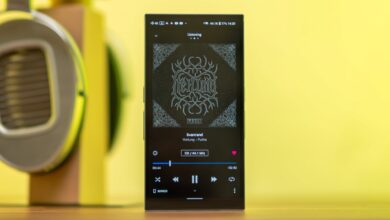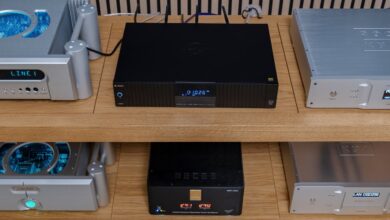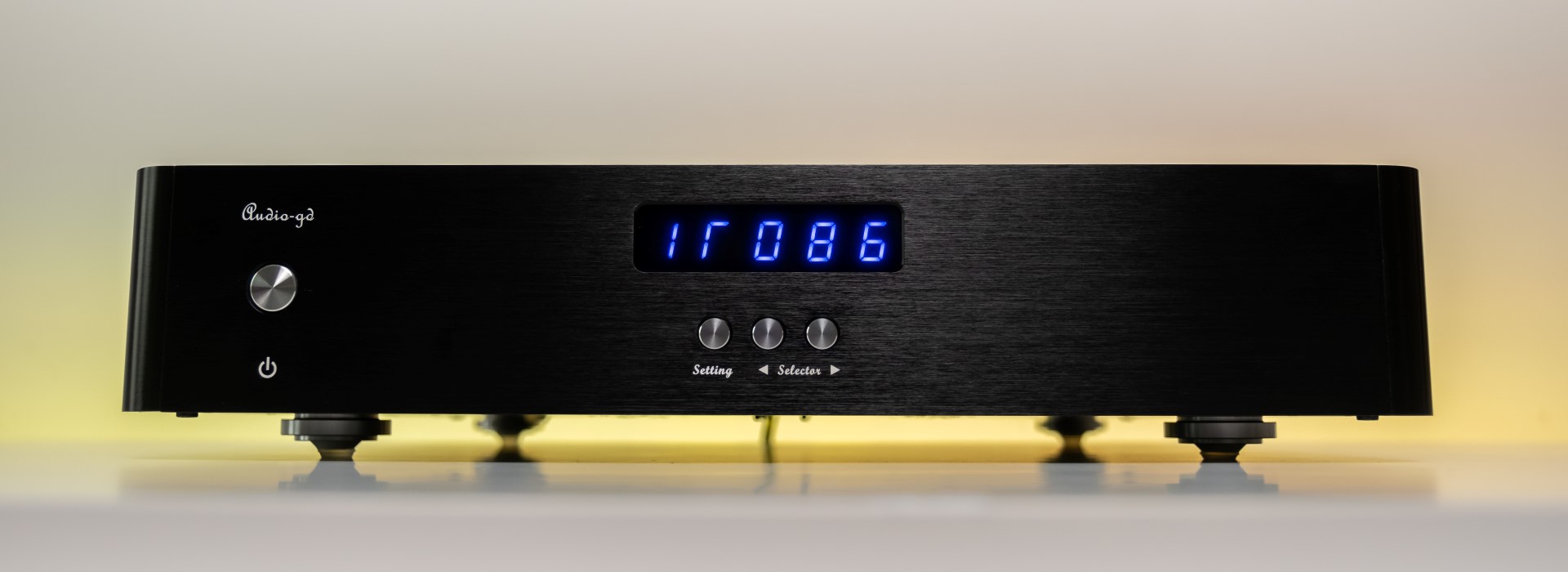
My Video Review:
I still remember it clearly when Audio-GD announced that they bought the latest batches of the best commercial made DAC chips from Burr-Brown, the legendary PCM1704 chips that everyone wanted to have in their digital sources. That news had a twofold effect on me. On one hand I was happy for them as the PCM1704 always had a strong cult following and I knew those will be implemented successfully considering the care Audio-GD is putting in the power filtering and how much importance they give to the output stage. One another hand, it was the end of an era, when those PCM1704 will be completely depleted, Audio-GD will need to move on and develop their own R-2R chips like Rockna Audio and MSB Technologies are doing for more than a decade now.
When Audio-GD announced their R2R-7 DAC using they own, custom made and custom engineered R-2R DAC modules, I knew it was the end of PCM1704 and a fresh new start for Audio-GD in the digital domain. There are hundreds of DAC manufacturers that are using their own metal cases, they own circuit boards and engineering and everything else are off-the shelf components supplied from all over the world. There are only very few DAC manufacturers on the face of the Earth that are not happy with off-the shelf components they can simply buy, so they started developing their own chips, their own software and their own code. I have a much bigger respect for the later ones as they strive for perfection no matter the cost and for more than three years now, Audio-GD is proud to be one of the companies that developed their own R-2R ladder networks and their own custom software that makes them tick and convert zeroes and ones into butterflies in our stomachs.
From a single module, they developed another one, so DA-7 and DA-8 modules were already been implement in hundreds of their devices. If you ever worked with a company from the land of the Red Dragon you probably know that they never really sleep on their laurels but are always tinkering with new stuff that might end as a new product or as a new series of products. Audio-GD recently updated their DA-7 and DA-8 modules to version 2 and as a direct result, their entire R-2R line-up was updated with fresh new electronics, software code and of course with a fresh new sound attached to them.
You might find around here few R-2R DAC reviews and you might think that I have limited experience with them. But in reality, I’ve listened to multiple iterations of them from multiple companies, the best ones and the most technical ones were always the Rockna Wavedream series and the MSB Technologies DACs. I remember their sound very clearly and I do still have the Denafrips Venus on loan so the DAC that I will be testing today came to the right party, I can’t wait to have a listen to it and compare it with the rest.
Audio-GD currently has 5 DACs in the R-2R resistor ladder category and R7 version 2020 seems to be the second best one from their line-up. R7-HE is basically the same R7 that I am testing, but with a built-in regenerative power supply making it completely immune to the dirty AC lines, preserving the integrity of the audio signal in its purest form possible.

Unboxing a Beauty & Unleashing a Beast
Disregarding loudspeaker packaging, the biggest box I ever received was for the Denafrips Venus DAC that looked to me more like a massive integrated amplifier than like a DAC. Now, imagine my reaction when the Audio-GD box came in and it was much bigger than the Denafrips one. Initially I thought that they changed their minds and sent their biggest integrated amplifier towards me, but no, it was the R7 (2020 version) in there. It comes in a massive box, inside it you will find the R7 wrapped in all that foam like a cocoon. Underneath it, a USB type-B cable can be spotted, another Micro-USB cable that will be used to upgrade your DAC with newest firmware – that might add some features in the menu or even improve or change the sound signature of your DAC. There is also a power cord and 8 silicone feet that can be attached to the stainless-steel feet, so it will not punch holes on the furniture it will sit on. There isn’t a user manual inside, for that I recommend checking the on-line version that you can find right here. R7 is not coming with a remote either, but considering that it is a pure DAC, without any preamp functionalities, it makes sense as a remote is not really needed.
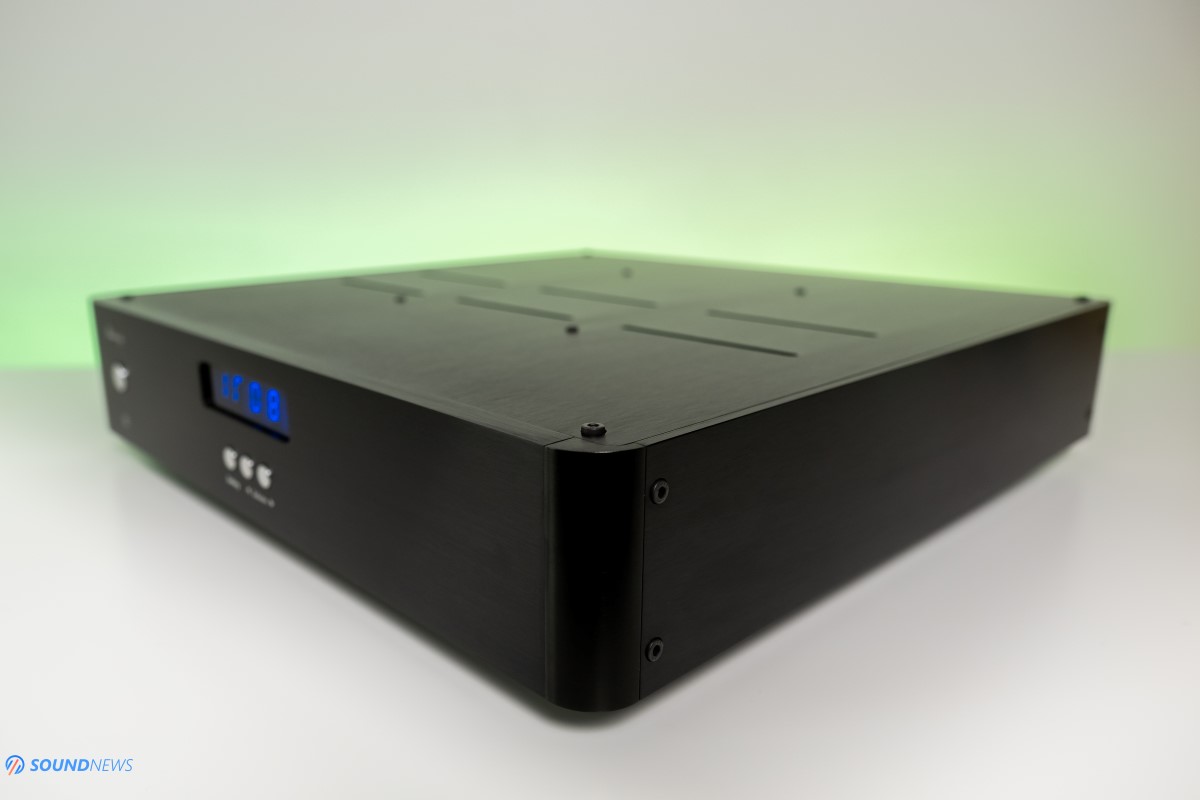
Design and Build Quality
This will be an interesting read as I really never seen a bigger DAC in my life, do note that R7-HE is even bigger and heavier than this one by an additional 4 kilos. Speaking about its weight, it might sound like a diva but it weights as an elephant, at a whopping 15 Kg or about 33 pounds, this thing is heavier than the KECES S125 Power Amp, heavier than my former Cambridge Audio Azur A851 integrated, heavier than the Denafrips Venus DAC and much heavier than any DAC or headphone amplifier I ever tested around here. It looks massive and really imposing too and once I put it near my other equipment, I started realizing how big it is. It simply dwarfed everything I have for testing and it occupied about one third of my desk table which is A Lot.
It looks very “Audio-GD” if you know what I mean. The front panel is made out of a 12 mm thickness aluminum plate, so there is a lot of aluminum put in this case. Compared to some DACs that are using thin metal bended around the corners, R7 is made out of CNC-ed aluminum and the thinnest panels are having 5 mm in thickness, which is a lot. Having such a thick metal case, you can be sure that it will be immune to any wireless interference, which is nice to have. I’m really glad that Audio-GD team dropped the lettering underneath the display (which would explain every letter or number on that screen), it looks much cleaner and elegant this way.
Just behind the display assembly are sitting three huge R-Core transformers that are dissipating quite some heat, so I would advise against putting something on top of it, it will need few centimetres for a good ventilation and heat dissipation. Under it, a hot power amplifier or integrated amp should be also avoided. For a long life and worry-free performance, I would put in on a rack or shelf.
It might look a bit rough around the edges with the bolts sticking out, which are not on the same level with the case and the raw aluminum buttons on a completely black unit are triggering my OCD, but other than that, it is built to last a lifetime and I didn’t felt for a second that they were cutting corners to have it more affordable or anything like that. I still think that it would be killer to have the buttons in dark-blue to match the color of the display (hint hint).

Controls & Connectivity
R7 is a pure DAC at heart, it doesn’t carry any preamp functionalities and as a result the volume knob was dropped which makes it look even better.
It has the simplest front panel, from left to right there is your On/Off button, followed by the settings button which engages its menu once pressed, then you have the selector buttons to navigate that menu. Once all the settings are done, leave it for few seconds and it will be back at displaying the default menu. If the settings button is not pressed, then the selector buttons will switch between 6 digital inputs.
The surprise comes when you take a look at the back panel, just look at that beautiful sight. It has all the digital inputs you could possibly want: AES, Coaxial, BNC, Optical, I2S (via HDMI socket) and USB. As for outputs, it offers 3 pairs of them as the usual RCA, XLR and something different called ACSS. If ACSS doesn’t ring a bell, that is a current driven analog output, that can be used with Krell equipment, with Bakoon Audio (SATRI inputs) products and with others.

Menu Settings
If you check the online user manual it might get a bit challenging to understand. You should know that every letter or number on that screen corresponds to a particular setting. It will display 5 characters on it, let’s check what they do:
- It has two positions: 0 and 1. 0 means you can use an external clock with it, 1 means you will be using its internal clocks, which by the way are the best commercial femtosecond clocks from Accusilicon and Crystek, so there is no reason to use an external one, leave it at 1.
- Two positions: t or r, from which the first one will mimic the sound of the older TDA1541A DAC chips of Philips – a bit slower and smoother sounding, awaking some sweeter harmonics in the process. The second one will disable that simulation. Use the one you like more. For a warmer and smoother presentation go for t, for a more detailed and sharper sound go for r.
- Two positions: O and N from which O – enables oversampling, N disables oversampling making it work as a pure Non-oversampling (NOS) R-2R DAC.
- If oversampling is engaged, the next letter will let you choose from 4 oversampling modes: 0 – disabled, 2 = 2X oversampling, 4 = 4X and 8 = 8X. The higher the number, the sharper and clearer the texture and outline of musical notes will be. If you like oversampling enabled, I suggest using 8X mode. If NOS is engaged, there will be 3 position to choose from: 1, 2 or 3. For now, they don’t do anything, but at a later date, Audio-GD might include some sound modifiers/filters.
- Select the desired digital input: 1 – AES, 2 – Coax, 3 – BNC, 4 – Optic, 5 – I2S, 6 – USB.
Pressing the settings button first, the 5th position will also enable or disable the backlight of the display. A – Auto, will disable the backlight after few seconds, N – display is always on.
I don’t find its menu very user-friendly and maybe they should update it with a simpler interface or maybe with color LCD screens in future iterations. It’s pretty decent now, but feels a bit old compared to the likes of Matrix Audio, RME, Mytek and others.

Tech Inside the R7 (2020)
R7 is using four DA-7 V2 modules for a fully balanced and fully discrete R-2R resistor ladder network. Manufacturer doesn’t specify the exact precision of those hundreds of resistors, but I can only presume that high precision ones were used. When designing a high-performance DAC, a lot of the magic is actually happening in the analog domain not only in digital. After opening up the unit, I understood the definition of going all-in in a DAC. Just take a closer look at those huge R-Core transformers, even big integrated amplifiers are not using so many transformers. Now look how much importance Audio-GD is putting to the output stage, it is simply massive and probably consumes a lot of energy. Power filtering is massive too, I see some big and juicy capacitors that will clean up the power and will store some of that energy for great dynamic swings. In all honesty, I never saw such a massive circuitry for a commercial made DAC, it is simply the definition of overdone and overkill in a very good way.
Some of the best DACs I’ve tested around here are consuming from 10 to maximum 25 Watts of power, seeing that R7 is consuming 48 Watts, it is a clear sign of how powerful is the output stage and how much power is needed to drive those four DA-7 V2 modules. It already sends clear messages of what I should expect from it in terms of scale, depth and definition.
Audio-GD used the best femtosecond clocks available today, 2 Accusilicon for all digital inputs and another 2 Crystek clocks for the USB input. They incorporated an USB Isolator too, even the tiny power supply for the USB board is a class-A power supply, that is nuts!
Since it has an R-2R network of resistors, a CPU and a very complex custom FPGA code is needed to execute all those commands. I observed that R7 has a slightly hotter output of 2.5V on RCA and 5V on XLR which is actually great news, since the amplifier that will follow, will be less stressed reducing the total harmonic distortion in the process for the same SPL compared to a colder output of say 4V on XLR.
I really like that all critical and sensitive parts of R7 were completely isolated by thick metal plates, so the power transformers, the digital board and the output stages are all isolated from for any kind of wireless or magnetic interference for a pitch-black background.
There are many things that I can write about, that I will skip for now, R7 is a very complex DAC from an engineering point of view and if you want to learn more about it, check its working principles by accessing the following link.

Test Equipment
This might sound weird to you, but some things are much easier to spot with top-of-the-line headphones (like for example detail, speed, kick, frequency response) and there are other things that are easier to spot with loudspeakers (holographic image, stage size, depth) so it was mandatory testing it in two very distinctive setups.
- In the headphone system, R7 was connected to the Benchmark HPA4 via balanced XLR and then to a pair of Audeze LCD-4 and Hifiman Arya – first ones for the extreme sub-bass presence, detail and kick and the later ones for the treble response. I later connected it to the Flux Lab FCN-10 to check if the transient response and slam is top notch.
- In the speaker setup, R7 was connected again to the Benchmark HPA4 working as a preamp, followed by a KECES S125 power amp, powering the Buchardt S400 loudspeakers. I used the same balanced interconnects and power cables in both setups.
Enough with the talk, I’m eager to test this Goliath of a DAC with as many musical genres as I can.

Sound Performance
I. Tonality & Timbre
Once I started playing with Oversampling, Non-oversampling, enabling or disabling the TDA1541A mode (PLL), I understood that this will not be an easy review to write. You can make it sound super technical and transparent by enabling 8X oversampling and disabling PLL, you can make it smooth, very natural and extremely textured by enabling NOS mode and PLL, or you can match between them to have the best of both worlds if you want. I sincerely never experienced such a big change in sound with any other DAC. With typical delta-sigma ones based on ESS or AKM designs, there are between 5 and 7 digital filters to play with, but those are changing the frequency response past 20 kHz, past our hearing abilities, so in practice the difference is zero or close to zero between those filters. On some R-2R DACs, like the latest ones from Denafrips, you can choose OS or NOS mode and that is it – the difference was there and it could be detected with transparent sounding drivers. However, on R7, it is on a whole new level as you can tune it exactly to your liking. Subjectively speaking, coming from a delta-sigma DAC, OS in 8X mode with PLL disabled sounds incredibly close to my reference DAC, with few things improved and with few others toned down a bit.
I want to point out that if you enable OS in 8X mode and disable PLL, you will still be listening to an R-2R DAC, so a lot of its traits will carry over no matter the settings you are choosing. Soundstage size and depth were always on the top of their game, R7 is really the definition of open wide sound, it is an airiness monster and probably the best when it comes to very precise 3D pin-point imaging. No matter the setting, R7 had a very palpable texture to it, I could almost feel those acoustic instruments and their bodies. If you read some of my articles by now, you probably observed how much importance I give to the transient response, it is still the main reason Denafrips Ares didn’t impress me that much. R7 is very different in this regard and once PLL is disabled, I’m feeling a massive air force being carried towards me with every note. With an enormous output stage like that, it would be un-natural having a slow or a mellow transient response. There is one area in the frequency response that always begs for attention on R7: that creamy, full-bodied, deep and fat bass response. It is probably the first time I can say that my former Matrix X-Sabre Pro and my current Matrix Element X were beaten at their own game! R7 has it impressively layered, it goes really deep and can be maintained longer if the track is asking for it. I can only presume that those huge R-Core transformers and the overkill capacitance played a big role in achieving such an impressive low-end. When it comes to R-2R DACs, this is currently the one that won me over and might even turn me to the dark side, embracing the R-2R for good.
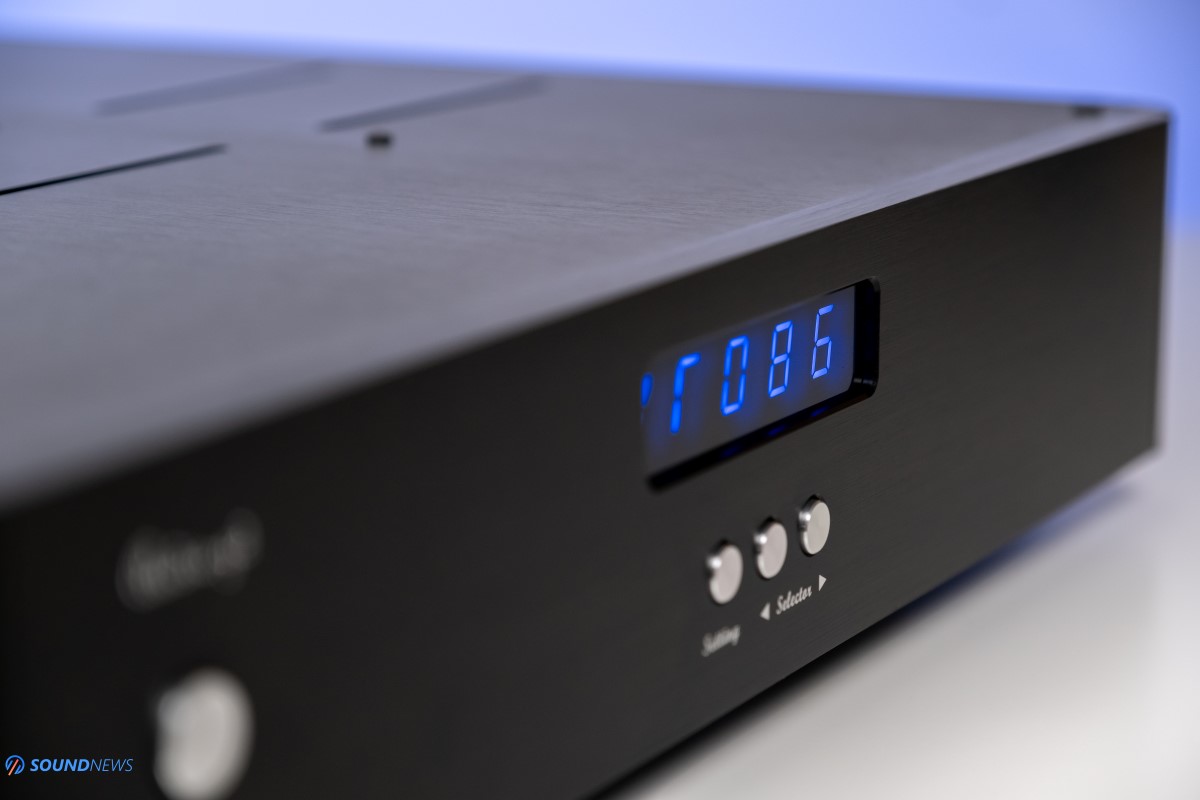
II. Background Noise
The Benchmark HPA4 and the Sparkos Labs Aries are not only great preamps and headphones amps but for me they are my best tools at checking the background noise of any digital source. If there is a deviation from absolute linearity or some background noise, they will show that without flexing a muscle.
I went as far as listening to R7 at a higher listening volume with some of my reference recordings just to strengthen my initial impressions. I did the same using speakers and I stayed close to them searching for for a disturbing hiss. No matter what I did, it sounded absolutely dead silent from very sensitive IEMs, to big headphones and loudspeakers. I would be surprised to hear any noise, considering how big is the power filtering and how impressive is the isolation of all digital inputs. The background is as dark and as silent as I heard it on Element X being powered by a passive power conditioner. The funny thing is that if I remove the power conditioner, other sources are reacting accordingly and are lowering down the transparency, but I can’t say the same about R7. With or without a power conditioner, R7 sounded absolutely the same in my home and my acoustic chain – it was always clean, transparent and free of any kind of noise.

III. Transient Response
This is a chapter where I would normally tell you that delta-sigma DACs outperform any R-2Rs, but at this point I no longer know if any of that is valid for the R7. If I am engaging PLL, somehow mimicking that TDA1541A sound, then there is a very distinct rounding of all musical notes, like their shape is not that defined and their impact is softened. Disabling PLL and enabling OS 8X, the speed is improving tremendously, offering a heftier kick in the chest that I can’t recognize it anymore.
Once I connected the Flux Lab Acoustics FCN-10 to it and put some BassKase – Once Upon A Time In The Midwest (Tidal / Spotify), I was mesmerized by the huge impact of the drums, by the texture and by how deep the bass guitar could go. Normally, this record should put me into a relaxed state and it did, but the groovy nature of this album was more apparent and more engaging than usual. The second song is absolutely rad, I don’t think I ever encountered such a powerful bass guitar, such a nice treble presence and kick. Pair it with a transient monster like Flux Lab FCN-10, Benchmark HPA4 or with a Hegel integrated amplifier and you will hear the definition of transient response with your speakers and headphones.
As far as R-2R DACs go, from the ones that I have tested around here, Audio-GD R7 takes the spot as the hardest slamming DAC and the one that knows how to impress a transient nut like myself. In absolute terms, comparing with the best of the best, I still think Element X is outperforming it when it comes to speed and R7 outperformed them all when it comes to raw slam and kick.
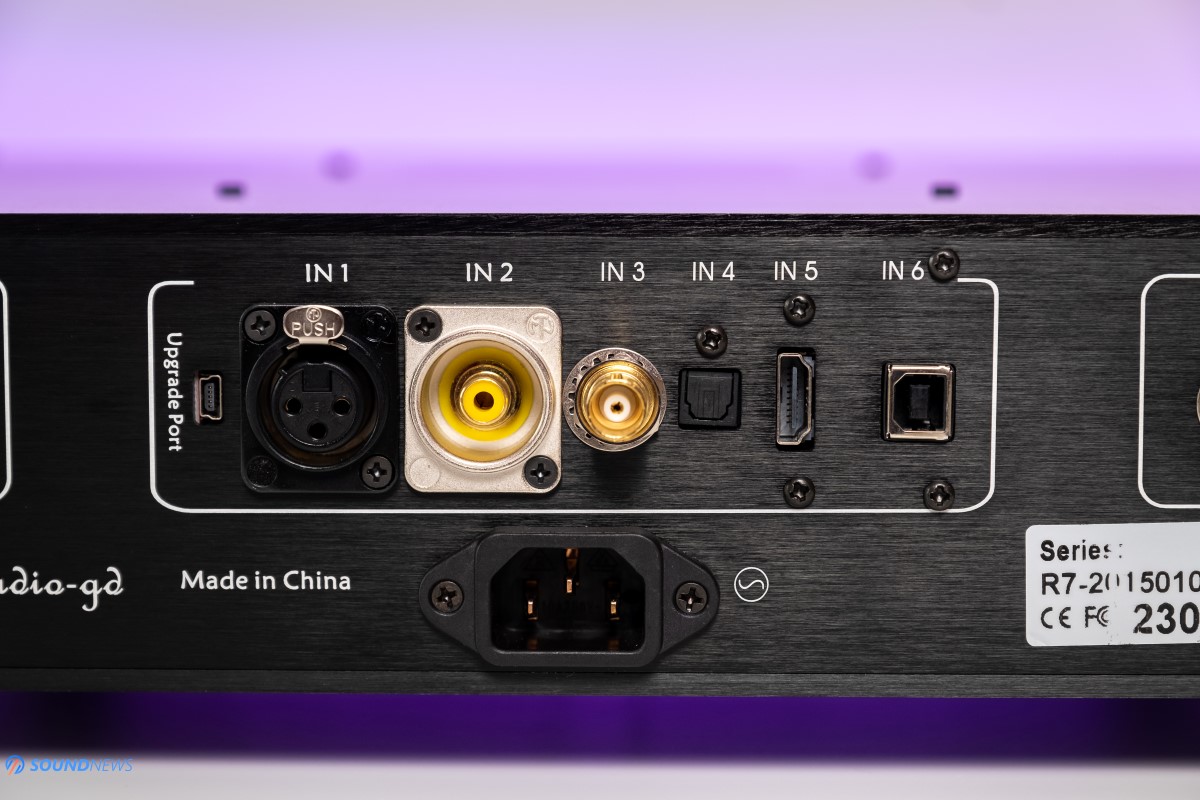
IV. Resolution & Transparency
If you are searching for details, then I strongly recommend disabling the TDA1541A mode, (PLL off) that will improve the sharpness, increasing detail level and the leading edge of every note. Having such a clean background and an absolute silence between passages makes the R-2R network and FPGA coding do their jobs much better.
As with all R2R DACs, resolution is not really priority number one, but transparency and texture is. For example, Matrix Element X might extract a bit more resolution out of a very good recording, on the other hand with R7 I can better feel the naturalness and texture of acoustic instruments, midrange becomes sweet and intimate, I can look deeper into my music, space between all notes increases tremendously and I can just pass by every note much easier with my imagination. Listening to Dancing With The Moonlit Knight by Genesis (Tidal / Spotify) the guitar plucks are becoming life like, treble has the right amount of zing without being too much, detail retrieval is on a very high level without attracting too much attention to it. It’s there in right doses and you can spot it if you know where to look.
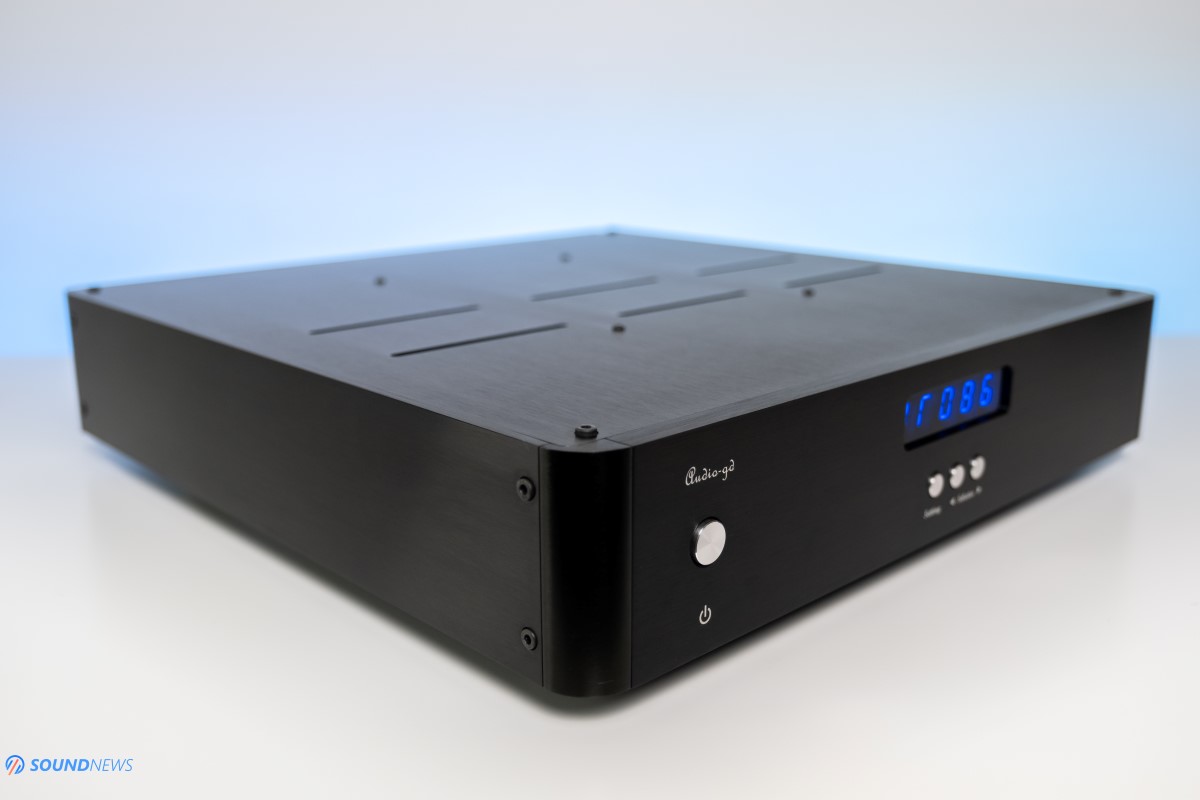
V. Soundstage & Depth
I don’t know how the older R2R-7 DAC or any other R2R design by Audio-GD sounded, but R7 (2020) is not kidding around and it is throwing it farther away than javelin throwing Olympic champions. Simply put, some of the music is almost unrecognizable, it is incredible how much more air was hidden there somewhere. I want to be clear, if a song is recorded in a small recording studio, then by any means it will sound exactly like that, but if I’m listening to some live records, it simply opens up and widens the stage to the maximum your speakers or headphones are capable of.
Even listening to some symphonic metal like Therion – Jotunheim (Tidal / Spotify), I couldn’t believe how much space opened up in the background. Drums are much more defined, multitude of voices on different tonalities are not touching each other anymore, there is simply more air and more space in the room. When piano and female voices started singing charmingly, the hair on my hands started raising, I was absolutely stunned. Listening to Ship of Luna (Tidal / Spotify) I was impressed by how big, yet how fluid everything sounded, so pleasantly natural and textured. When acoustic guitar started playing accompanied by soprano voices, I again felt like staying in a much bigger room and my body was somehow much smaller.
Moving to the living room, feels like I should rewrite my Buchardt S400 review, especially the soundstage & depth chapter. S400 are already crazy good when it comes to pin point imaging, localization of all notes and stage size. With R7 at the top of the acoustic chain, I’m feeling like I’m listening to a big full-blown stand floor speaker system, the spaciousness is dialed up to eleven and I feel the need to move the couch farther away from speakers, otherwise the sound picture becomes too big and wide in that listening spot.
In terms of scale and stage size on all three axes, I’m adding another champion to my list: R7 and Venus are currently the undisputed winners. Who will take the number one spot? We shall see, in the comparison below.

VI. Frequency Response
R7 feels like quite a departure from all other DACs I had the pleasure of testing. The biggest highlight for me was that deep and controlled bass performance. There were quite some DACs that had an amazing low end, like Topping D90 or Matrix Element X as few examples, but boy, R7 is a different animal altogether. Combine it with a hard-slamming amplifier and you will unwillingly lower down your usual listening volume, because of those punchy bass notes and because of the incredible dynamics.
The R-2R DACs that I have tested in the past were good in here, particularly Venus was great in the bass, but they didn’t outperform the best ones at bass depth, detail, definition and kick. Listening to Infected Mushroom – More Than Just A Name (Tidal / Spotify), I realized than finally I can compare the bass performance with the best delta-sigma DACs and not only that, it actually outperformed any other source in the bass department. I’ve heard an impressive kick and an amazing sustain, bass went down to the sub-sonics, it rumbled, it punched and it raised my mood. I didn’t feel it like a deviation from linearity, more like this is how bass should be played and maintained. The powerful output stage is surely having the last word in this frequency range.
It doesn’t come as a surprise to anyone that a big majority of R2R sources have a soul-grabbing midrange performance, a denser and a much fuller tone. They always shinned in here and R7 is no different really. I’m glad to report that I am not spotting a decrease in transparency how was the case of Denafrips Ares. R7 is presenting the midrange completely grain free, very involving, musical and pure. The nice thing is that no matter the settings you change in that menu, the midrange will always remain natural and deep.
Another pleasant surprise was hearing the high-pitched sounds very defined and clear, detailed and transparent but without the shrillness and brightness a cheap digital source will offer. There isn’t a sign of a roll-off, it goes up to the highest octaves in a detailed but non-aggressive way. When it comes to treble, Engaging OS 8X and disabling PPL, felt like listening to the Matrix Element X, I felt it transparent, defined, the micro-detail was there too. The only thing that went missing was the extra crispness and the sharpness that ESS Sabre designs are having.

VII. A Comparison
Since Denafrips Venus is still on loan and both are more or less in the same price bracket, it was natural comparing two of the best R2R DACs available on the market.
Audio-GD R7 2020 Version ($2668) VS Denafrips Venus (~$2822 in the US / ~€2967 in EU)
In terms of build quality, both are carved out of thick aluminum plates on a CNC machine, both are very big, bad n’ heavy and both are the definition of overkill. Venus has an encapsulated power supply made out of two toroidal transformers plus tens of electrolytic caps for filtering and for power reserve. Audio-GD went slightly above that and used 3 R-Core transformers, surrounded the power supply with a thick metal plate and again used tens of fat electrolytic caps for filtering and for a big power reserve. In terms of I/O, both are on the same level with a slight advantage to the R7, since it offers and additional output: ACSS. Both are pure DACs only, without preamp functionalities, they don’t have remotes, bells and whistles. In terms of build quality, there is nothing to reproach to both of them, they are big, bold and both manufacturers went overkill in the digital and analog sections.
Before listening to them I needed to volume match them since Venus is outputting 4.4V and R7 a hotter 5V output. MiniDSP E.A.R.S is showing a difference of about 1.3 dB between them which is obvious while listening. I volume matched them using the Benchmark HPA4 and started a long listening session.
In the OS mode, R7 had a fuller and a meatier tone. It sounded bolder, more visceral and carried a better kick with every note. Bass notes were definitely going deeper and punched harder on R7. To this day, R7 offered the best bass response I had the pleasure of hearing in a DAC. The treble had just a hair more texture to it and went slightly higher, it was more defined and had a clearer edge. R7 sounded a bit more transparent and it reminded me a lot about my own Matrix Element X.
While listening to electronic music, I observed that the R-2R network responded faster on the R7. Especially listening to Noon by Infected Mushroom, at the 0:51 mark there are some lightning fast digital sounds that are rendered almost perfect on R7, but slower and losing definition on Venus. R7 worker considerably better with electronic music and in general with fast and engaging music.
When I moved to Venus, music felt calmer a bit, less rough and more refined. It felt more linear in the frequency response but a bit boring by comparison. I longed for the fast transient response and slam of the R7. While listening to any kind of acoustic music, Venus felt really relaxed, easy going, smoother and gentler. It would instantly relax me by calming my spirits and would remind me that music is not only about fast transients, hard slam, but also about refinement and smoothness.
In terms of soundstage, depth and pin-point imaging, both units are showing me the limits of my speakers and headphones. They both offered the same impressive open wide sound, that is deep as lake Baikal, offering an exact pin point location of every note in a very 3D way. Both are still kings in the soundstage department.
Enabling NOS (non-oversampling mode) and that PLL, R7 became super smooth, very relaxed, creamy, extremely musical and meaty, you get my point. I personally don’t like listening that much with PLL engaged, but I get why some of you might like this setting. With R7 you can also combine some of the settings, for example disabling PLL and remaining in NOS mode – this is favorite NOS setting. It is still musical and textured, but is not losing detail and speed this way. Bottom line is that with R7 you can really tune it to your liking and every setting can be easily felt, unlike the digital filters of delta-sigma DACs. From ultra-sharp to ultra-smooth and musical, everything is possible on R7.
Venus on the other hand has a simple OS/ NOS button and no additional settings. NOS mode is just barely different compared to OS mode, but there is still a difference. It becomes even smoother and calmer, notes are less sharp and defined. It works extremely well this way with bad mastered music and with old music. Harsh sounding records are cured in this mode, you can listen to the unlistenable this way.
Both are amazing digital sources and there is a lot to hail about them and very little to criticize about. It is clear to me that both have quite a different approach to music reproduction, please don’t ask me which is better, it depends on your personality and music taste so ask that yourselves and you will get your answer.
Subjectively speaking, R7 can be fast and slow, Venus can’t be as fast, R7 can be bold, punchy, a bass canon if you want, or a gentle giant depending on the settings, Venus can’t be that raw and naughty, so personally for me, R7 is a better unit and it is also cheaper too.
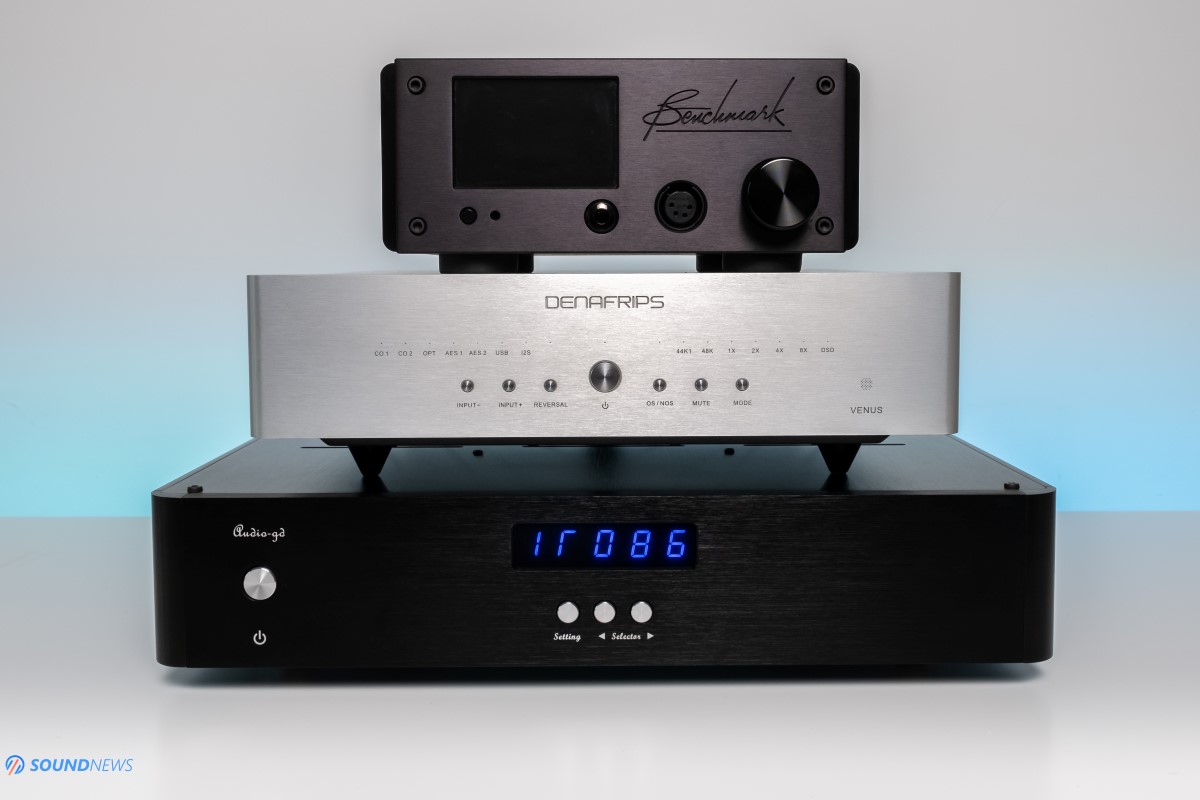
Conclusion
This was the most difficult and the most rewarding review to make. It is a first when I can call the same DAC slow and fast, hard slamming and easy going, super detailed and rolled off. Since R-2R DACs are relying a lot on the FPGA code, the manufacturer is basically telling it how it should sound, not the other way around as it happens with delta-sigma ones. If you like to tailor your sound or if you change your acoustic chain quite often and worry about system matching, then Audio-GD R7 seems like a perfect digital source to own, it is really a chameleon and a system matching God.
It shown that I’m yet to discover new things especially in the low end, there are still more layers and more air to be moved down there, which is quite impressive. R7 with that oversized power supply, filtering and output stage sounded as the meanest and the punchiest DAC I’ve tested and it’s exchanging uppercuts with Denafrips Venus for the title of the airiest, the widest and the deepest sounding DAC.
Audio-GD R7 is not a cheap DAC by any means, but considering its immaculate and shape-shifting sound properties, I consider its price of $2668 fully justified. You can get it directly from the Audio-GD right here.
PROS:
- Incredibly big and solid device
- Its built like a tank and weights like one too
- Widest possible soundstage, deep sounding too
- Precise pin point imaging, with a very 3D holography
- Linear frequency response and super extended on both ends
- Impressive levels of transparency and resolution
- Probably the best slam and kick I’ve encountered in a DAC thus far
- Lacks any noise and distortion, black as night background
- Full-bodied, rich in tonality and life-like sounding
- Widest selection of digital inputs
- Sound signature can be altered with tens of different combinations: from fast to slow, detailed to relaxed, sharp to musical, everything is possible
- Good price for an immaculate performance
CONS:
- A remote control would be nice
- The menu is confusing at first
ASSOCIATED EQUIPMENT:
- DACs: Audio-GD R7 (2020 version), Audio-GD D28, Denafrips Venus, Matrix Audio Element X, KECES S3, Burson Conductor 3 Reference, Flux Labs Acoustics FCN-10, Gustard A22
- Headphone Amps: Benchmark HPA4, SparkoS Labs Aries, xDuoo TA-30
- Preamps: Benchmark HPA4
- Integrated Amps: Hegel H190, Keces E40
- Power Amp: Keces S125
- IEMs: FiiO FH7, FA9
- Full-sized headphones: Audeze LCD-4, Erzetich Phobos, Hifiman Arya, Quad ERA-1
- Loudspeakers: Buchardt S400, KEF LS50W
- Interconnects: QED Reference XLR (x2), Aune AL3 XLR
- Speaker cables: Kimber PR8, Audioquest Type4
- Power Cables: Isotek EVO3 Premier (x2)
- Balanced Isolation Power Conditioners: PLiXiR Elite BAC400, KECES BP-600



